K.M. Sulpya
RECAST
Kirtipur, Kathmandu, Nepal
I. BACKGROUND
Sweetmeats are identified as a traditional food and primarily processed within villages or household groups (as a cottage industry). Production provides a good source of income and employment.
Sweetmeats are deep fried in ghee (fats from milk) or edible oil. Colours, flavours and toppings are added before or after frying. There are many varieties of sweetmeats using different raw materials. The nature of the products varies in form, texture or moisture content, etc. Some of the most popular sweetmeats in the rural as well as in the urban communities are: jilebi, sel and lalman. Some sweetmeats are mixed with khuwa (whole milk solids).
In Nepalese society, sweetmeats such as jilebi, swari or sel are consumed along with tea for breakfast. There is a special caste called the ‘Rajkarnikar’ whose main job is to cook sweetmeats. They are normally economically sound in comparision to other castes. But nowadays other castes also produce sweetmeats because it is profitable.
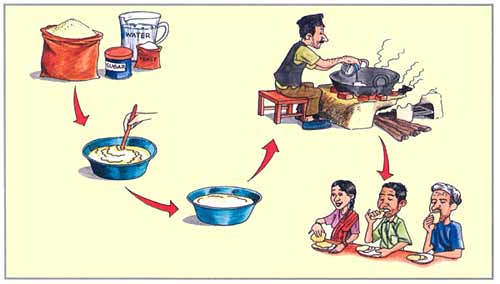
Sweetmeat production flow diagram
Every roadside restaurant, sells these items. Sweetmeats are also used as offerings during morning prayers. Sweetmeat are consumed in many areas of society and are widely available.
Fuelwood is the major source of energy used, however in places where it is expensive and where alternatives are available such as in Kathmandu and other cities, fuelwood is replaced by kerosene and LPG fuel.
The source of fuelwood for sweetmeat production is mainly from the country's progressively dwindling forest stock. In cities, timber offcuts are also used. In rural areas, fuelwood is transported mainly by human labour (or by foot). Only hard wood species of wood are used. The availability of hardwood species such as Sal (shorea robusta), Chilaune (Schima wallichi), Karma (Adina cardifolia), Katus (Castonopsis sps.), etc. is inconsistent, which has resulted fuel price hikes.
Sweetmeats are often produced and sold on site. These small scale businesses generally employ one or two labourers. The owner is responsible for training his employees.
II. THE STOVE
Normally, the stoves used for sweetmeats production have one-pot hole without a chimney. The stove is well-built. To reduce heat loss, very small pot supports are used. The round bottomed pan also sinks into the combustion chamber for better heat transfer to the pan. When a flat bottomed pan is used, small bricks are placed around the pot to prevent heat loss and also shield the cook from the heat. In some stove designs, a great is used for better wood burning.
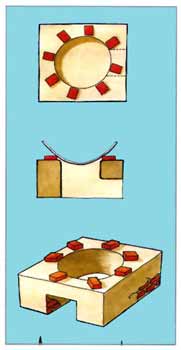
2.1 Stove Construction and Materials
The stoves are made of the following materials: 40 pcs of bricks, mud, agri-residues, dung, metal supports, and wood support. To construct the stove, mud is mixed with cow dung and some agri-residues. In some stoves, a metal frame is used in the wood feeding hole.
The interior of the stove is shaped like a cylinder. Pot supports are used in the stove to protect the cook from the heat. Temporary bricks/tiles are kept surrounding the pot support. The dimensions of the stoves vary considerably from 24 cm to 30 cm inside diameter and with a height of about 30 cm to 40 cm. The stove has a single opening of about 16 cm that serves as fuel feeding hole.
III. THE FUEL
Fuelwood is the main fuel used in sweetmeat processing. Waste wood from timber processing is available in the market, size ranges from 60–210 cm long and from 3 to 7 cm wide.
During operation, between 2 and 4 firewood sticks are kept for burning depending on the size of the firewood. Kerosene or small pieces of firewood are used for kindling. If the combustion chamber becomes too hot, firewood is removed.
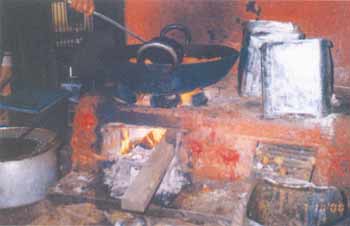
Typical of stove used in sweetmeat production
3.1. Heat and Combustion
In the process of sweetmeat production, the pan is filled up with about 5 litres of ghee or edible oil. The pan is heated by burning fuelwood with high intensity; when the ghee begins to boil, the cooking process starts.
Normally, well-dried wood is used for fuel. On average the moisture content was 13 percent during the author's observations. The wood burns yellowish red and the hot flue gases pass directly under the pan. During the study, the combustion was better and produced less smoke. The cook said that sometimes he has to use wet fuelwood which produces a lot of smoke.
During the stove use, the maximum temperature of the fire was estimated at 812 degrees Celsius; the temperature lowered when the fuelwood was added.
After completing the cooking process, the charcoal and ash are removed. Water is sprinkled on the charcoal and it is reused for space heating, tobacco smoking, or cooking meals in a special stove. Ash is used as a cleaning powder for plates, pans, pots, etc. After the cooking process, the temperature of the stove was around 520 degrees Celsius and slowly reduced.
3.2 Stove Operation and Maintenance
During production, heat is controlled by adjusting the amount of firewood. The stove does not have any mechanisms of secondary ventilation like an air hole, grate, gate. The stove is well-maintained by the cook.
3.3 Cooking Utensils and Design
For sweetmeats production, big pans (round bottomed or flat bottomed) are used. For deep frying round bottomed pans are preferred because the bottom part is embedded in the combustion chamber.
IV. SWEETMEAT PRODUCTION PROCESS
The raw materials used to make sweetmeats include buffalo meat, wheat flour, yeast, ghee, sugar, edible oil, khuwa, edible colours, etc. The ingredients are purchased in local markets and the cost varies from region to region. The supply of ingredients is not regular and the prices are increasing.
For jilebi cooking, wheat flour is mixed thoroughly with water, sugar, edible colour and fermented yeast in a bowl by stirring vigorously. After standing for one hour, the semi-liquid mixture is poured into the boiled ghee (milk fat) or edible oil according to the size of the jilebi required. Depending on the size of the pan, many jilebi can be cooked.
After some time, the jilebi is cooked and removed. The process continuous until they finish the mixture.
The general condition of the kitchen is messy but there is sufficient light and ventilation. The workers sit for the duration of the production process.
4.1. Tricks Employed During Processing
During processing, continuous firing was observed in two processing units. Both the stoves are the same design but differ in dimensions. The cooks are well-trained. However, in one stove, the cook used a metal support around the wood feeding hole to protect it from wear and tear during use. The combustion chamber is also smaller and has a grate for better burning. But the metal grate lasts for one and a half months only.
Both the stoves use small bricks around the pot ring to protect against heat loss from the pot hole.
V. PROBLEMS AND CONSTRAINTS IN THE UTILIZATION OF STOVE
The main problems faced by the shop keeper are the smoke emissions from the stove and the consumption of fuelwood which is increasingly difficult to obtain use.
For some sweetmeats, the cook prefers to use fuelwood to produce a strong heat and speed up the cooking process. Some cooks use both fuelwood and LPG in their stoves.
VI. ECONOMIC ASPECTS
6.1. Cost Calculation of Stove Production
| The existing traditional stove costs | Rs. 165 | |
| Bricks 40 pcs | Rs. 60 | |
| Mud | Rs. 10 | |
| Agri-residue | Rs. 5 | |
| Dung | Rs. 5 | |
| Metal supports | Rs. 50 | |
| Wood supports | Rs. 35 | |
| Total | Rs. 165 | |
As seen from the calculations above, sweetmeat (jilebi) production has an excellent return on the initial investment (profits amount to 59% of the total investment). There are 2 or 3 shops every 100 meters in cities like Kathmandu and sweetmeats are easily available in roadside restaurants.
6.2. Fuelwood Used in Total Production Process
Based on the case studies, the consumption of fuel varies between the two different kinds of stove. It is observed that on an average cooking one kg of jilebi (sweetmeat) consumed 0.446 kg of fuelwood in one stove while another stove consumed 0.597 kg of fuelwood. This was primarily due to the size of the stove on average 0.515 kg of fuelwood is required per kg of jilebi. The cost of fuelwood per kg of jilebi is about Rs.2.06 (3.4% fuelwood cost per kg. of jilebi).
6.3. Analysis of Sweetmeat Production
| Sweetmeat production units | :Kathmandu valley |
| Stove type | :One-pot-hole stove without chimney |
| Fuel type | :Fuelwood |
| Employees | :Three |
| Operation | :3 hours |
| Working days | :350 days |
| Total Investment | |||||||
| a) | Fixed cost | ||||||
| a.1) Fixed asset | : | stove production | - | Rs. | 165. | ||
| pans | - | Rs. | 800. | ||||
| bowls | - | Rs. | 160. | ||||
| stirrer with hole | - | Rs. | 120. | ||||
| plate | - | Rs. | 350. | ||||
| Rs. | 1,595. | ||||||
| b) | Variable Cost | ||||||
| b.1) Working capital | : | fuelwood for 2 weeks | - | Rs. | 600. | ||
| labour cost for 2 weeks | - | Rs. | 990. | ||||
| raw materials 1 week | - | Rs. | 4,500. | ||||
| sugar, wheat flour, yeast, ghee, edible colour, etc. | - | Rs. | 6,090. | ||||
| Total investment | Rs. | 7,685. | |||||
| Annual Production Cost | |||||
| 1. | Depreciation : pans, bowls, etc 10% | - | Rs. | 159. | |
| 2. | Investment on fixed assets 18% interest on Rs. 1196. | - | Rs. | 215. | |
| 3. | Raw materials cost per year costing of: | ||||
| wheat 1759 kg | - | Rs. | 19,250. | ||
| sugar 3500 kg | - | Rs. | 84,000. | ||
| ghee 2187 kg | - | Rs. | 153,125. | ||
| edible colour 26.3 kg | - | Rs. | 5,250. | ||
| yeast 7 kg | - | Rs. | 2,100. | ||
| Total | Rs. | 263,725. | |||
| 4. | Direct labour cost | - | Rs. | 23,760. | |
| 5. | Cost of fuelwood (40 kg/day) | - | Rs. | 14,000. | |
| 6. | Cost of water + electricity | - | Rs. | 2,100. | |
| 7. | Interest on working capital | ||||
| (50% of Rs.6090 at 18%) per year) | - | Rs. | 548. | ||
| Total annual production cost | Rs. | 304,507. | |||
| Annual Sales | |
| On average total production of jelebi = 20 kg/day | = 7,000 kg/year |
| Per kg jilebi | = Rs.60/ |
| Total annual sales | = Rs.420,000. |
| Total profit | = Rs.325,493.(excluding tax) |
| Annual profit equals to 59% of the total investment. | |
Table 1. Results of Sweetmeat (Jilebi) Cooking Tests
| Stove A: Ram K. Rajkarnikar | Stove B: Mahendra Rajkarnikar | ||||||
|---|---|---|---|---|---|---|---|
| Weight of Jelibi cooked | Quantity of Fuel used | Weight of Jelibi cooked | Quantity of fuel used | ||||
| Day | (kg) | (kg) | Time(hr) | Day | (kg) | (kg) | Time(hr) |
| 1 | 20.2 | 9.0 | 5.00 | 1 | 22.2 | 12.5 | 4.45 |
| 2 | 22.0 | 8.2 | 4.80 | 2 | 20.5 | 11.3 | 5.00 |
| 3 | 18.7 | 9.6 | 5.20 | 3 | 14.3 | 8.3 | 4.10 |
| 4 | 16.6 | 8.1 | 5.50 | 4 | 13.8 | 7.9 | 3.95 |
| 5 | 22.9 | 9.9 | 6.10 | 5 | 18.5 | 11.6 | 4.90 |
| Avg | 20.1 | 8.96 | 5.32 | Avg | 17.86 | 10.6 | 4.48 |
Remarks: Pan balance was used for the tests
Fuelwood with 16% moisture content
Stove A: WBT - 16.2 PHU with 37 gm/min BR
Stove B: WBT - 14.7 PHU with 48 gm/min BR.
VII. SUGGESTIONS FOR FUTURE DEVELOPMENT
Sweetmeat production is a very profitable business. In cities, the main problem is the smoke emissions which pollute not only the shop keepers house but also affect neighbours. Because of this people are switching from fuelwood to kerosene or LPG but there are certain items which are best produced with firewood. Kerosene and LPG fuel are also not consistently available.
Based on analysis of stove use some suggestions for future development are as follows:
A chimney or chimney hood should be incorporated into the stove design.
A metal grate should be introduced for better combustion,
A round bottomed pan should fit more deeply into the combustion chamber.
If a chimney is not used, the pot support should be small as in the Thai Bucket Stove so that heat loss can be minimised. This will also ensure that the cook will be exposed to less heat.
The kitchen or working area should be clean and the cooks should stand while working instead of sitting. Improved working conditions may make the work more attractive to young people.□
K.M. Sulpya
RECAST
Kirtipur, Kathmandu, Nepal
I. BACKGROUND
Pop-rice (golphaki) is a very popular food item in Kathmandu Valley and in the southern part of Nepal. People in Kathmandu Valley offer this food to Sitalamai, the goddess of smallpox. If a child contracts smallpox, the villagers go to the temple of Sitalamai and worship her so that the child will get well. A portion of the pop-rice thus offered is taken back and given to the child. Since smallpox has been eradicated from Nepal the practice of worshipping the goddess associated with smallpox has lessened. In the southern part of Nepal (Terai), one can see people selling and buying pop-rice. The Riksha-three-wheeler pullers, carters and other poor people eat pop-rice as a dietary staple when they cannot afford to buy a heavy meal of rice and bread. Pop-rice is a very light edible item. It is indispensable in the Terai region. There are many restaurants in Nepalese cities that offer sekuwa (small pieces of meat roasted in charcoal) which is eaten along with pop-rice, radish and lemon. This item is inexpensive and very popular.
Pop-rice processing is a small scale village industry which falls under the category of cottage industry. According to Suwal (1988), the pop-rice processing area is quite distinct in the villages. Workers normally live together and one can see households of 25–30 in one area producing pop rice. Production is usually a family business but some groups employ labour for transportation of the finished product.

Pop-rice production flow diagram
The raw material used in this industry is mainly rice. Other materials which are required include earthen pots, fine sand, sieves, and winnowing trays.
The people involved in this business are generally poor. They don't buy fuelwood. Fuel collection is done by the household members. Forest weed (Eupatorium odonoforum) is available everywhere. This weed is also known to be a forest destructor because when the weed dries it becomes highly flammable. Twigs, branches, bushes, leaves etc. are also collected.
The villagers are illiterate, and so they don't keep track of their labour costs. Every two or three days some members collect fuel; the weeds, twigs are tied in bundle and left in the sun until dry.
II. THE STOVE
2.1. Stove Design
The stove use for pop-rice production is traditional. There are three-pot holes in the first series and one-pot hole in the back. The stove is fixed to the ground floor or outside the house. In the first two-pot holes, there are no pot supports while small pot supports are used in the third pot hole. The pop-rice stoves in the Machhegaon village are small. The height of the stove is 17 cm, pot holes are 16 cm diameter, a wood feeding hole is 12 cm × 10 cm. The wood feeding hole is made small and accommodates weeds, agri-residues, and branches of trees.
2.2 Stove Construction and Materials
The stove is made of mud-bricks. Mud is mixed with cow dung and chopped rice-straw. The exact proportions are not known. The stove can be made within 2–3 hours, though it must dry for several days before it can be used.
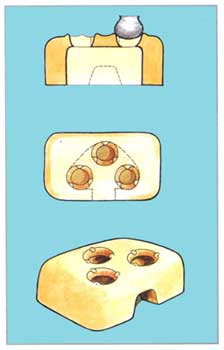
III. FUEL USED AND PREPARATION
Rice husk, forest weed (Eupatorium odonoforum), wheat straw, maize stalks, maize cobs, twigs and branches, bushes, etc. are used for fuel. First, they place 2–3 kg of rice husk in front of the stove and place some inside the stove (fire box) as a fuel bed. Forest weed is then added (5–6 sticks at a time) with a regular dusting of rice-husks inside the fire box. The forest weed is 1 cm in diameter and about one meter in length.
3.1. Heat and Combustion
All the pop-rice producers in Machhegaon village use low grade fuel. For good power output and continuous heating, a rice husk bed is used. Rice-husk increases the power output. The twigs and forest weeds are air-dried before use. During the study, the moisture content is found to be 18 percent. During the combustion, fuel burns yellowish to light red. The fuel is pushed towards the pot hole on the right which has a pot which contains sand. The temperature recorded here is around 710 degrees Celsius, while the temperature in the left pot hole is around 615 degrees Celsius and the temperature in the back pot hole is around 518 degrees Celsius. Temperature fluctuates as fuel is added. Sometimes the temperature falls 400 to 500 degrees Celsius.
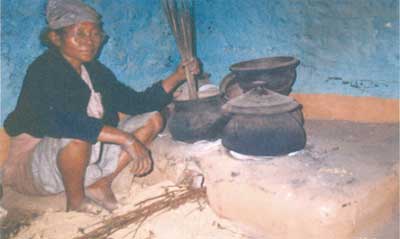
A typical of stove used in pop-rice production
After completing the process, the residual ash are removed. They are used as cleaning powder for plates, pans, pots, etc and also for soil improvement in the garden.
3.2. Operation and Maintenance
Heat is controlled by adjusting the amount of fuel. The stove gets light impact because of light fuel used. Red clay mixed with cow dung is used for plastering from time to time.
3.3. Cooking Utensils and Design
Cooking utensils are only round bottomed earthen pots. The size is 20 cm height and 18 cm diameter (pot base).
IV. PRODUCTION PROCESS
Paddy is soaked in water for about one day in a special pot called a phoshi. The paddy is then boiled in the phoshi after which the water is drained out and the paddy is air-dried. The paddy is then heated in hot earthen pots until it begins to pop up. The paddy should not be completely popped. Complete popping will covert the paddy into a different thing known as lava or pop-paddy which is required especially for auspicious occasions.
The incompletely popped paddy is then dried in the sun for two or three days. It is then taken to the mill to separate the chaff from the rice. Some use a traditional threshing device. Clean rice obtained after winnowing is popped for a second time in an earthen pot containing heated sand. The pot is strongly heated. Three such earthen pots (two containing sand and one which is empty) are placed in series over the three-pot-hole stove.
In the three-pot-hole stove, three earthen pots are heated but two pots contain sand while handful of rice grains is warmed up in the empty pot. Certain mechanisms or tricks are applied so that more heat goes towards the first pot containing sand when the sand is sufficiently heated and turns red-hot then it is poured into the empty pot containing warm rice. As the warm rice-grains come in contact with the red hot sand, they start popping up almost instantaneously. Immediately the second pot containing sand which receives lower heat is poured in to the first pot to heat it up a bit. Continuous stirring of the grains gives them a uniform heat. Each grain rice is enlarged in size as it pops.
The mixture is then poured into the sieve. Fine sand passes through the pores of the sieve leaving behind the inflated snow-white rice grains which are called pop-rice. The process is repeated continuously until complete.
V. PROBLEMS AND CONSTRAINTS IN THE UTILIZATION OF STOVE
Pop-rice production is a long process. Only one handful rice-grains is heated at a time; thus the cook has to work 10 to 12 hours per day. The stove produces smoke. In the absence of fuelwood, the cook normally uses forest weed, rice husk for fuel bed and agri-residues. Because of this the cook has to pay continual attention to the fire.
Production difficulties and competition with products from the southern part of Nepal have forced some producers to abandon their activities.
VI. ECONOMIC ASPECTS
6.1. Cost Calculation of Stove Production
The existing traditional stove costs about Rs.40.
| Bricks (20 pc.) | Rs. 30 |
| Mud | Rs. 5 |
| Agri-residues | Rs. 2 |
| Dung | Rs. 3 |
| Rs. 40 |
6.2. Capital Input vs. Economic Output
As seen from the calculations (see Annex 1), pop-rice production has a very low profit in comparison to other activities. Two day of work yields an income of Rs. 161. The Nepalese are not satisfied with their situation but have limited options.
6.3. Fuelwood Used in Total Production Process
Case studies suggest that fuel consumption does not much vary from one stove user to another. The stoves
are more or less of equivalent size.
On average 17.4 kg of fuel was consumed for making 12.72 kg of pop-rice. That means, producing 1 kg of pop
rice requires 1.37 kg of fuel.
Fuel is not purchased for this activity but rice husks cost Rs. 1.50 per kg. Assuming the same price for weed, the percentage of fuel cost to total production cost is 5.6 percent.
6.4. Production Cost and Economic Analysis of Pop-rice Production
| Pop-rice production centre | : Machhegaon village |
| Stove type | : Three pothole stove |
| Fuel type | : Weeds, agri-residues, twigs, bushes, etc. |
| Employment | : Family member |
| Operation | : 8–10 hours |
| Working days | : 3 days in a week. |
| Average production cost/day | |
| Paddy 42 kg | - Rs. 315. |
| Rice husk | - Rs. 4. |
| Fuel collection (half day) | - Rs. 30. |
| Labour (2 days) | - Rs. 120. |
| Total | Rs. 469. |
| Sales | |
| 42 kg paddy gives 12.72 kg pop-rice | |
| 12.72 kg pop-rice: Rs 480 (whole-sale price) | |
The profit equals to Rs. 11 only but the people involved in this business do not count their labour. Excluding labour the benefit they got is Rs. 161.
Table 1. Results of Pop-rice Production Tests
Stove A: Nuchhe Maya Maharjan
| Biomass Used for Paddy Steaming (12 Pathi) | Biomass Used for Paddy Heating (12 Pathi) | Wt. of Rice Grain Produced | Biomass Used for Pop-rice | Wt. of Pop-rice Produced | |
| Day | (kg) | (kg) | (kg) | (kg) | (kg) |
| 1 | 5.0 | 5.5 | 21.5 | 6.0 | 12.75 |
| 2 | 4.8 | 5.9 | 20.4 | 5.3 | 11.90 |
| 3 | 5.3 | 6.1 | 22.3 | 5.5 | 12.50 |
| 4 | 5.5 | 5.2 | 22.8 | 6.6 | 11.00 |
| 5 | 4.5 | 6.0 | 20.99 | 6.4 | 13.15 |
| Avg | 5.02 | 5.7 | 21.5 | 5.96 | 12.16 |
Stove B: Sun Maya Maharjan
| Biomass Used for Paddy Steaming (12 Pathi) | Biomass Used for Paddy Heating (12 Pathi) | Wt. of Rice Grain Produced | Biomass Used for Pop-rice | Wt. of Pop-rice Produced | |
| Day | (kg) | (kg) | (kg) | (kg) | (kg) |
| 1 | 5.5 | 6.0 | 22.0 | 5.9 | 12.54 |
| 2 | 5.3 | 5.2 | 21.5 | 7.8 | 13.48 |
| 3 | 4.9 | 6.5 | 23.3 | 6.2 | 11.60 |
| 4 | 4.8 | 5.5 | 20.2 | 6.1 | 10.50 |
| 5 | 6.0 | 5.5 | 22.8 | 6.8 | 13.86 |
| Avg | 5.3 | 5.74 | 21.96 | 6.64 | 12.48 |
Remarks: Pan balance was used for the tests.
Local ‘Pathi’ was used and converted into kg.
Stove: A: WBT - 13.6 PHU with 41.6 gm.min kg BR.
Stove: B: WBT - 14.4 PHU with 34.62 gm/min BR.
VII. SUGGESTIONS FOR FUTURE DEVELOPMENT
The people involved in this business, especially those in the Mechhegaon village of Kirtipur area are not satisfied with the price they receive from the dealers or shop keepers; unfortunately they have no alternative. They must work for 8–10 hours processing rice-grains into pop-rice on a wet ground floor and in an unmanaged kitchen.
Based on an analysis of the stove used, some suggestions for future development are as follows:
A chimney or chimney hood or kitchen window should be introduced for smoke removal from the kitchen.
Proper lighting and installation would contribute to a better kitchen environment.□
Hil J. Padilla
AGTALON
2430, Pangasinan
Philippines
I. INDUSTRY BACKGROUND
1.1. Brief Information on Salt Making Techniques
There are 2 methods of salt making in the Philippines.
A. Solar Bed Method
This method is locally called “balara”. First, salt water is channeled into shallow ponds. The water is then evaporated through solar radiation and the salt that cakes on the bottom is scraped. This process yields coarse salt granules usually referred to as “rock salt”.
The two major drawbacks of this method include the use of polluted sea water in urban areas and the coarseness of the granules. Some regions of the Philippines only use fine grained clean salt. If balara salt is used in the preparation of fermented fish sauce for “bagoong” and “patis”, the resulting product is of poor quality. However, the production method is inexpensive as it does not use fuel.

Dripping salt to dry
B. Cooked Salt Method
This method is mainly used in the province of Pangasinan, the study site. The place is also noted for “bagoong”. Pangasinan literally means salt making place. Salt is made by evaporating salt water in large open vats with heat source from biomass cookstoves.
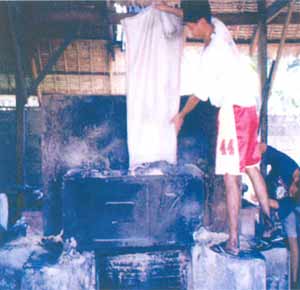
Pouring the rice husks
The method produces very clean, fine grained salt. Impurities are removed during cooking. Prolonged boiling sanitizes the salt, thus satisfying a requirement in the preparation of fermented fish.
To save fuel, some salt makers use partially evaporated salt water from solar ponds. The concentration of the salt is ready for cooking when the branch of a tree that grows near brackish water floats. Sometimes a hard rubber material is used to determine the salt concentration.
An innovation by inland salt producers is to buy the coarse, cheap “balara” (rock) salt, dissolve it in water and re-evaporate it. “Balara” salt is currently P120.00/50 kg bag while the “cooked” salt is P250.00/bag. To increase salt yield other producers use salt water to dissolve the rock salt. The mushrooming of this kind of salt making industry is one indication of its viability as a business enterprise.
1.2. Development of Stove Used
Traditionally, the stove used in salt making is a wood-fueled. The efficiency of the stove is increased by enclosing the fire box with walls or by embedding the stove under the ground, with a smoke outlet at the other end. The salt processing sites are located near seashores. Usually, a processing venture is run by one household as a cottage industry and uses family members for labor. In the late 1970's wood became more expensive and difficult to collect, prompting a shift to rice hull stoves.
It was also the time when the rubber roll type of rice mill replaced the “Engelberg” (steelhuller) type. The rubber roll is sometimes called the “2 pass miller”. The rice is first dehulled by the 2 rubber rolls rotating at 2 different speeds and then the grains are passed on to a metal jet polisher. The rubber roll produces ‘rice hulls’ whereas the 1 pass Engelberg type produces rice bran.

The fuel entrance to the combustion chamber
The abundance of rice hulls in inland rice producing
areas made it economically feasible to reprocess the
“balara” salt. In general, the scale of these rice hull
fired salt making industries is bigger than their woodfueled
counterparts.
Rice hulls constitute about 14–16% of the harvested
paddy weight. About 8 to 9 million tons of rice hulls
are produced each year in the Philippines. If properly
utilized, rice hulls could become a substantial
renewable resource.
The actual energy content of the rice hull is 6.000 to 6.800 BTU/lb or 14 to 16 MJ/kg. This amount is about the same as wood waste burned as fuel from timber production industries. However, it has a high ash content (16 to 23%) which makes the energy content per unit volume rather low.
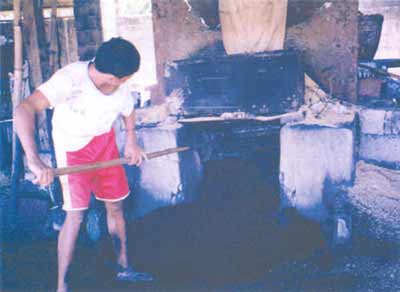
Cleaning up the ashes to keep air flow into the combustion chamber
The origin of the rice hull stove design is unknown. In the Philippines, it is called the “ipa” (rice hull) stove and used in different industries like mushroom making, restaurants, etc.
They are mainly constructed by local masons. In Yogyakarta and Central Java, it is called the “Tahu” (soy curd) stove. In Blitar, East Java, it is called “Gula Jawa” (coconut sugar) stove.
1.3. Problems and Constraints in Stove Utilization
The main problem with the woodfed stove is the high cost of wood which reduces the net income. The high cost of wood makes the rice hull stove more attractive. In the salt factory studied, the cost of one 10-wheeler truck load of rice hull is only P200, and delivery is free. Others gather hulls as waste from rice mills. In many rice mills, millers pay contractors to remove and dispose of rice hull; they are thus pleased to offer the hulls to local entrepreneurs who can make use of them.
One of the problems with the rice hull stove is the high amount of residual rice hull ash. In the factory studied, the ash is dumped in the seashore. Rice hull ash is becoming a pollutant. Although rice hull ash is a very good soil conditioner, very few farmers use it.
The rice hull stoves also release more smoke compared to woodfuel stoves with the same design. Some salt makers prefer wood because it requires less attention during the cooking process. However, in the rice hull stove studied here, smoke was not much of a problem for the workers because of the chimney.
The rice hull stove is also expensive to construct. The stove makers charge P4,500.00 per concrete stove with ceramic lining. The stove pan made of flat G.I. sheet costs around P700/pan and one stove uses two pans making it P1,400/stove. Some resource poor salt makers use clay with bamboo lining rather than clay, bricks and concrete lining for their stoves; also they use only one pan. Properly constructed bamboo lined stoves are as durable, so this modification is not a problem.
Workers complain that rice hull make them itch. Although cooler than the open type stoves, the workers using rice hull stoves still complain about the relatively hot working environment.
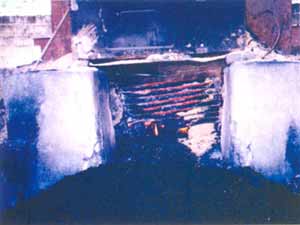
The grate of the stove used in salt production
Visual inspection of the stoves seems to suggest that they are the same. However close observation of the cooking process reveals that they differ much in efficiency. The efficient stove could process 3 loads in 16 hours, while the other stoves could accommodate only 2 loads. This is not due to the skill level of the workers, because if they switch stoves, the results are the same. The workers are paid by the number of loads processed. So, the workers with a more efficient stove earn 33% more. A minor change in the stove design like the position of the grate made the difference between the two models. Modifications will be discussed in the following sections.
Although the cost of rice hull fuel is minimal, the amount of fuel used could (approximately 250 kg rice hull/cooking) still further be reduced if there is improvement in the efficiency of the stove and consequently, a lessening of work and production cost.
II. STOVE TESTING
The first stage of the study included a survey of the salt industry and the different stoves used. We visited three salt factories, each of which used the same basic rice hull stove design but with occasional differences in the dimensions. Observations of the cooking practice and interviews with workers on the characteristic of the industry were conducted. For comparative purposes, a woodfuel fed salt factory was also visited.
The biggest of the three factories (with 14 stove units) was chosen for stove testing. In this factory, the 2 fastest cooking stoves (stoves that could cook 3 times per day) and the 2 slowest stoves (stoves that could cook only 2 times per day) were selected for testing. These stoves have the same pan sizes and stove dimensions and position of grate, (inclination of tunnels and size of tunnels going into the chimney). We noted that the stoves had approximately the same performance even when the workers change, which suggests that the difference in performance is due to stove design rather than skills of workers in managing the fire.
The short water boiling test and the long water boiling test were used to assess (as described by Waclaw Micuta, please see attachment for methodology). The 2 water boiling tests could also be considered cooking tests as the cooking method is evaporating the salt water. So, in the first test, instead of using tap water, salt water with salt concentration of 200 was used. Ambient air temperature and climatic conditions during the were also noted.
Four stoves were studied, the 2 fastest and the 2 slowest. Two replications were taken.
III. RESULTS AND DISCUSSIONS
3.1. The Industry and Its Requirement
The salt processing industry studied employs the “cooked salt” method earlier described. “Balara” or rock salt derived from evaporating ponds is bought usually from local “balara” salt producers or imported from other countries like India. This is then dissolved in salt water and then cooked in wide shallow pans using rice hull as fuel. The resulting product is a clean, fine granules salt which is then sold at a higher price.
The Salt Making Procedure
(Please see production flow diagram)
The dissolving tank usually made of concrete or wood lined with epoxy sealants, is filled with about half of the required amount of water. A plastic net screen covers the top of the dissolving tank. When rock salt is poured through the screen, large impurities are withheld from the tank. The other half of the required water is then poured into the tank to further dissolve the salt. Motorized water pumps are used. The ratio of salt to water is such that it will have a reading of 20 on the barometer. At this factory, workers no longer use the barometer because the tanks have been pre-calibrated. Workers can fill water up to the appropriate marking on the walls of the tanks.
By means of gravity, the dissolved salt is poured by workers into the cooking pans. The pans are filled 1 inch below the rim to allow room for boiling so the solution won't overflow.
Then it is cooked until salt granules form but are not crystallized. If cooked until dry, it will burn or form big chunks which are difficult to pulverize. So, when there is still a small amount of water, the small salt granules are scooped and transferred to bamboo baskets located just above the pans supported by wooden planks. Excess water drips back into the pans. The baskets remain there until the next batch of cooking is about to be harvested. It is worth noting that during the cooking process, the dirt floating on top of the boiling salt water is removed with nets sewn in metal rings and thrown away.
While the harvested salt is drying, another batch of salt water is added into the remaining water in the pan. The remaining water in the pan is around 15–20% of the original amount. Then the second batch is cooked as outlined above. But after around six rounds of cooking, the remaining water is thrown out and replaced. If the remaining water is not discarded after so many rounds of cooking, the salt quality suffers.
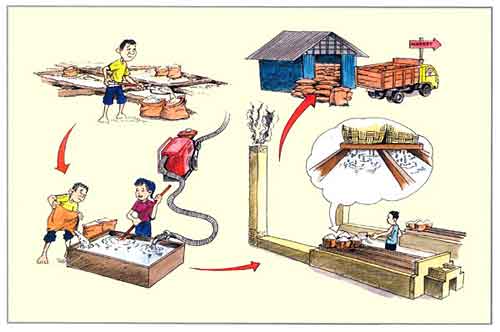
Salt making production flow diagram
Cooking Utensils

Coolking pan - made of gauge 18 plain G.I. sheet
3.2. Stove Design
Stove Dimensions
The size of stove is 249 cm long, 125 cm wide and 60 cm high. The size of chimney is 315 cm long, 50cm high, and the length of the channel is 107 cm.
Stove Materials
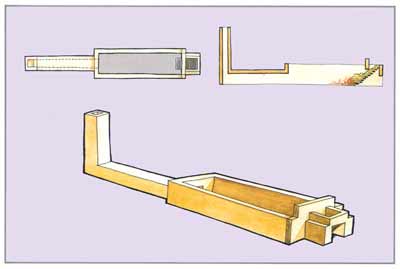
3.3. Stove Operation and Maintenance
The main cooking trick employed is directly related to time management.
The fuel hopper is filled with rice hulls. Some of the fuel will slide by means of gravity down into the grate. The fuel is then lighted at the bottom of the grate using paper as kindling material.
The grate will become full of ashes which will impede air flow and the introduction of additional fuel. The ashes are removed periodically, allowing a fresh batch of fuel to slide down. The ashes are loaded into baskets and dumped elsewhere. In this factory, it is dumped on the shoreline, thus polluting the nearby sea.
Cooking is quickened by using a very intense fire in the beginning of the cooking process until the time when the salt is about to be harvested. Sometimes a very intense fire will make the boiling water overflow. Harvesting of salt starts when granules form. The granules begin floating when there is still around 20–25% of the original amount of water left. The salt is then scooped into the dripping basket above the pan. While dripping, the pan is filled with salt dissolved earlier in the tank. The refill will come to a boil quickly. Before retiring for the day, the stove is filled with another load to maximize the remaining heat and fuel and left until the following day. This technique allows more salt to be cooked.
The fuel is loaded into sacks by women, whereas the cook usually loads the fuel. One women may supply 4–8 stoves and will be paid by the number of sacks.
Stove maintenance mainly consists of cleaning the chimney. Minor repairs are rare due to the sturdy
concrete stove material used.
It is also interesting to note that the workers use the boil water for food preparation.
3.4. Stove Efficiency Computations
A. Test Conditions and Cooking Test Results
The test conditions and the results of the actual cooking test are shown in table 1 at the following page.
The data was obtained under normal cooking conditions. The stoves had been used at least once before the data was taken, thus the initial water temperature in the pan ranged from 38–43° C as compared with the water temperature of the tank which is 30–32 °C. The rice hull fuel registered 15% moisture content.
Although the 4 stoves have the same general dimensions, stoves C & D have an inclined channel going into the chimney. From the top view the channel in stoves A & B are straight while in stoves C & D, the channels after the main stove body are wide and tapers to the chimney. The chimney dimensions are the same for all 4 stoves.
Although the pans have the same dimensions, the data shows that stoves C & D contain more initial salt water volume (C=463.5 liters; D=487.5 liters) compared to A & B (A=434.0 liters; B=421.0 liters). One liter was assumed to be 1 kilogram. This disparity can be explained by the relative mounting of the pans; in A & B, they are inclined a bit and tend to spill at one end if overloaded, whereas C & D are more level. Stoves C & D were constructed recently and have and have corrected the earlier flaw.
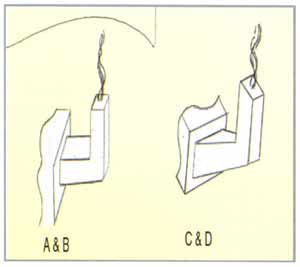
Stoves C & D boil the mixture significantly faster even if it contains a higher volume of salt water. Accordingly, they consume a higher amount of fuel. The style of tunneling creates a better air draft which allows for increased consumption, as will be explained in the following sections.
| Test condition: | |
| Replicate 1 | Replicate 2 |
| - Fair weather/sunny | - Fair weather/sunny |
| - Average Temp - 30C | - Average Temp. -32 C |
| - Moisture Content of Rice Hull - 15% | - Moisture Content of Rice Hull - 15% |
Table 1: Actual cooking test results
| StoveA/ Rep1 | StoveA/ Rep2 | StoveB/ Rep1 | StoveB/ Rep2 | StoveC/ Rep1 | StoveC/ Rep2 | StoveD/ Rep1 | StoveD/ Rep2 | |||||||||
|---|---|---|---|---|---|---|---|---|---|---|---|---|---|---|---|---|
| Fuel Weight Initial (kg) | 255.6 | 264.7 | 245.9 | 236.9 | 209.5 | 199.7 | 225.5 | 223.5 | ||||||||
| Weight of Unused Fuel (kg) | 25.9 | 27.6 | 13.0 | 25.1 | 5.0 | 0.0 | 3.0 | 8.8 | ||||||||
| Fuel Consumption (kg) | 229.7 | 237.1 | 232.9 | 211.8 | 204.5 | 199.7 | 222.0 | 214.7 | ||||||||
| Initial Salt Water Volume (kg) | 432.0 | 436.0 | 422.0 | 420.0 | 460.0 | 467.0 | 485.0 | 490.0 | ||||||||
| Remaining Water/After Evaporation | 64.0 | 80.0 | 68.0 | 64.0 | 121.0 | 90.0 | 80.0 | 100.0 | ||||||||
| Amount of Water Evaporated (kg) | 368.0 | 356.0 | 354.0 | 356.0 | 339.0 | 377.0 | 405.0 | 390.0 | ||||||||
| Salt Yield (kg) | 104.2 | 96.4 | 94.0 | 99.4 | 111.6 | 118.0 | 117.7 | 117.2 | ||||||||
| Time Consumed Till Salt Harvest | 6hrs-30 min | 6hrs-30 min | 6hrs-30 min | 6hrs-30 min | 4hrs-30 min | 5hrs | 4hrs-30 min | 4hrs-55 min | ||||||||
| Initial Water Temp. in Pan | 39 C | 39 C | 40 C | 38 C | 39 C | 42 C | 39 C | 43 C | ||||||||
| Time Consumed to Boil | 46 min | 45 min | 54 min | 56 min | 30 min | 28 min | 32 min | 30 min | ||||||||
Likewise, a similar trend could be observed in the time consumed till salt harvest and in the total amount of fuel utilized.
B. Specific Fuel Consumption, Percentage Heat Utilization, Power Output and Burning Rate
Specific Fuel Consumption and Rate of Cooking
The data reveal (Table 2) that stoves C & D have significantly lower fuel consumption, faster cooking, and higher salt yield.
Table 2 : Average fuel consumption, Time consumed till salt harvest and Salt yield
| Stove A | Stove B | Stove C | Stove D | |
| Fuel Consumption | 233.4 | 222.4 | 202.1 | 218.4 |
| Time Consumed till Salt Harvest | 6 hrs-30 min | 6 hrs-30 min | 4 hrs-45 min | 4 hrs-45 min |
| Salt Yield | 100.3 | 96.7 | 114.8 | 117.4 |
The specific fuel consumption was derived by dividing the total fuel consumed by the salt yield. Stoves C & D have lower SFC's than stove A & B, with stove D having the lowest (Table 3), followed by stove C.